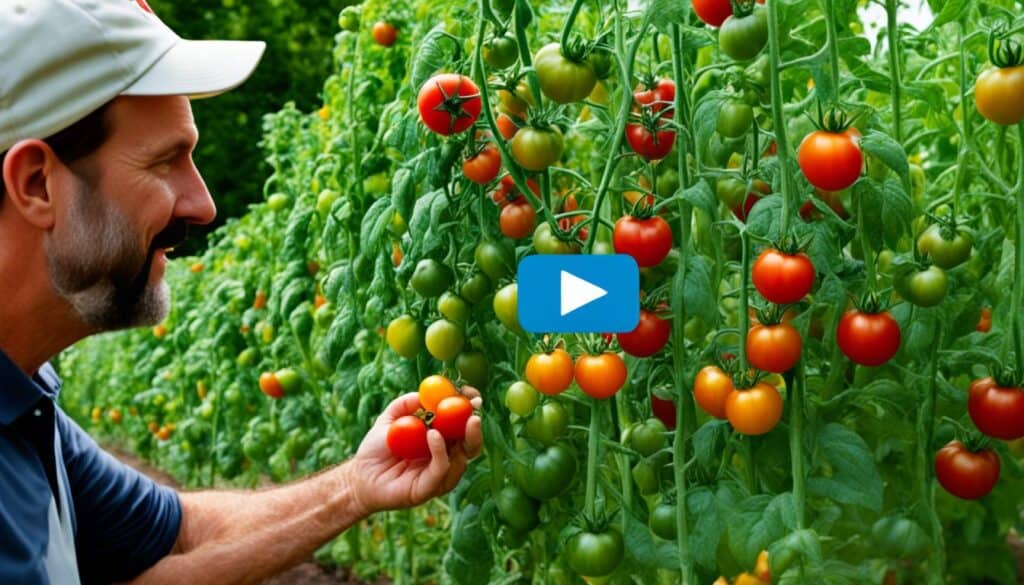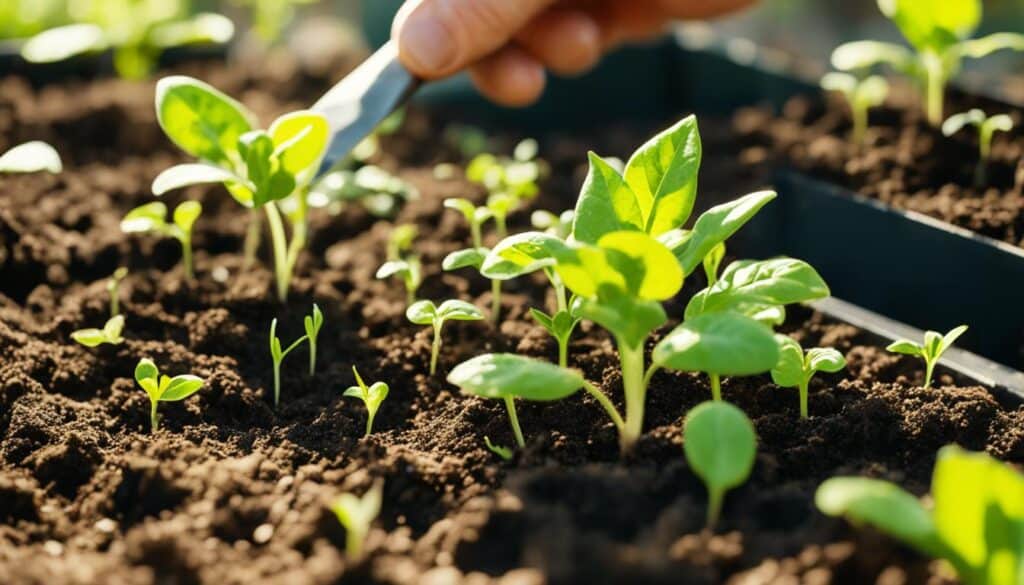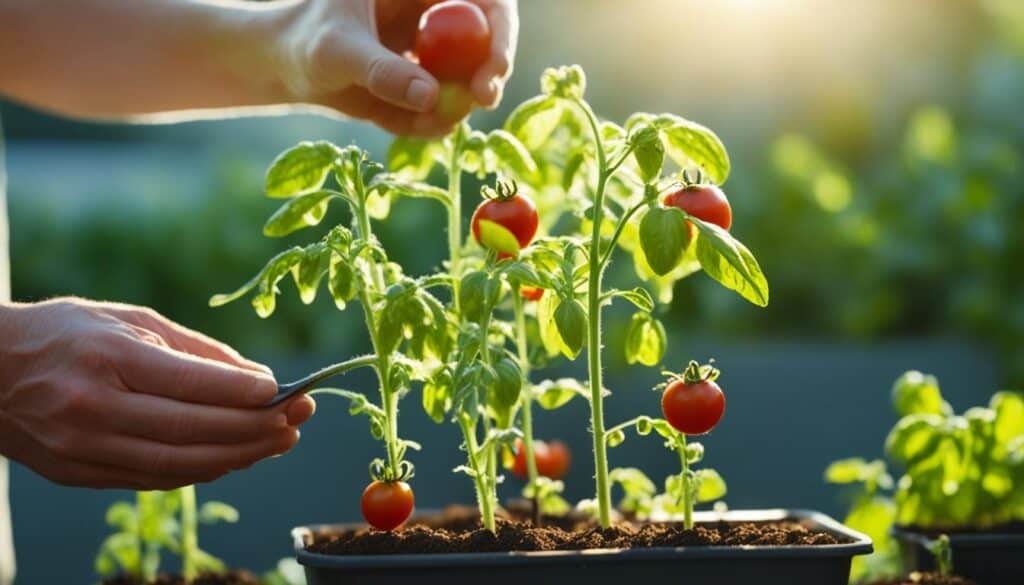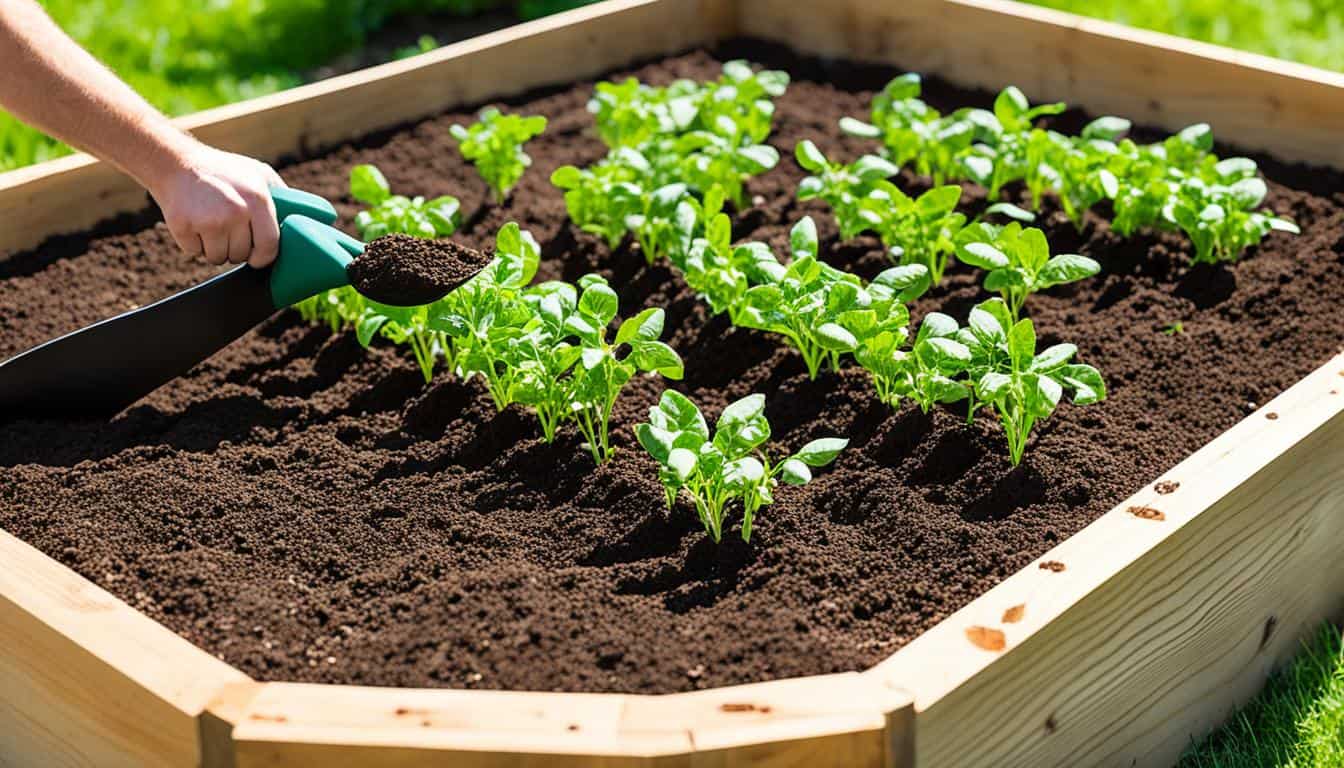Did you know that the Marmande tomato is not only a flavorful delight but also an heirloom variety? This organic gem is a top pick among gardeners, thanks to its juicy taste and natural growth. If you’re curious about growing Marmande tomatoes and want to learn all the tips and tricks, you’ve come to the right place!
Key Takeaways:
- Marmande tomatoes are beloved by gardeners for their juicy flavor and heirloom status.
- These tomatoes can be grown organically, making them a favorite among those who prefer natural gardening methods.
- If you’re interested in growing your own Marmande tomatoes, stay tuned for valuable information on choosing the right variety, caring for your plants, and harvesting the perfect crop.
- Whether you’re a beginner or an experienced gardener, there’s something for everyone in this comprehensive guide.
- Get ready to enjoy the fruits of your labor with homegrown Marmande tomatoes that will elevate your culinary creations.
Choosing the Right Tomato Variety
When it comes to selecting the perfect tomato variety for your garden, there are a few important factors to consider. Tomato varieties come in a wide range, each with its own unique characteristics and growth habits. Let’s explore some of the key considerations when choosing the right tomato variety.
Jointed vs. Jointless Tomatoes
One important distinction among tomato varieties is whether they are jointed or jointless. Jointed tomatoes have visible but weakened joints where the fruit joins the stem, making them prone to cracking under certain conditions. On the other hand, jointless tomatoes lack these weakened joints, resulting in a more durable fruit that is less likely to crack. Many organic farmers prefer jointless varieties to avoid potential fruit damage.
Determinate vs. Indeterminate Varieties
Another factor to consider is whether you prefer determinate or indeterminate varieties. Determinate tomatoes are compact and bushy, reaching a certain predetermined height and producing fruit all at once. They are perfect for smaller spaces and container gardening. On the contrary, indeterminate tomatoes are vining plants that can grow tall and require support. They produce fruit continuously throughout the season, offering a longer harvest period. These varieties are ideal for larger gardens with ample space for their sprawling growth.
Choosing between determinate and indeterminate tomatoes depends on the available space, gardening goals, and personal preferences. Determinate varieties offer easier management and are well-suited for gardeners with limited space, while indeterminate varieties provide an extended harvest and require trellising or stake support.
“The right tomato variety can make all the difference in your garden. Consider factors like jointed vs. jointless and determinate vs. indeterminate to select the perfect variety for your gardening needs.”
Recommended Varieties for Cold Climates
If you live in a cold climate, there are specific tomato varieties that are best suited for your region. These cold climate tomatoes are adapted to thrive in cooler temperatures, allowing you to enjoy homegrown tomatoes even in chilly conditions.
Black Cherry Tomatoes
One recommended cold climate variety is the Black Cherry tomato. These tomatoes produce early-season harvests of deep red to black cherry tomatoes. They are known for their sweet and rich flavor, making them a popular choice among gardeners.
Rouge de Marmande
Another excellent option for colder climates is the Rouge de Marmande tomato. These tomatoes have ribbed, large, flat fruits that are visually stunning in the garden. They have a sweet and tangy flavor that is perfect for fresh eating or incorporating into recipes.
Oxheart Tomatoes
The Oxheart tomato is an indeterminate variety that performs well in cold climates. These tomatoes produce large, meaty fruits that are perfect for sandwiches and slicing. They have a rich and juicy flavor that will satisfy any tomato lover.
When growing tomatoes in cold climates, it’s important to provide them with adequate protection from frost and cold temperatures. Consider using row covers or plastic tunnels to create a warmer microclimate for your plants. Additionally, planting them in raised beds or containers with well-drained soil can help ensure proper drainage and prevent waterlogging, which can be detrimental to the plants.
By selecting the right tomato varieties for your cold climate and providing them with the necessary care and protection, you can enjoy a successful tomato harvest even in cooler regions.
Best Varieties for Warm Climates
For those in warm climates, certain tomato varieties thrive in the heat. Here are three top picks that are known for their ability to withstand high temperatures and produce delicious fruit.
Burnley Gem
The Burnley Gem is an Australian heirloom variety that thrives in warm climates. It is a determinate variety, which means it has a compact growth habit and requires less staking or trellising. The Burnley Gem produces medium-sized fruit that is known for its rich, sweet flavor. It is best harvested in the mid to late season when the fruit is fully ripe.
Grosse Lisse
The Grosse Lisse variety is another excellent choice for hot conditions. This variety produces large, rounded fruit that is best picked slightly pink and allowed to ripen fully off the vine. Grosse Lisse tomatoes have a balanced flavor and meaty texture, making them perfect for slicing and adding to salads or sandwiches.
Patriot
The Patriot tomato is a hybrid variety that performs well in hot and humid areas. It is a semi-determinate variety, meaning it falls somewhere between determinate and indeterminate in terms of growth habit. The Patriot produces good-sized fruit with a classic tomato flavor. This variety is known for its heat tolerance and disease resistance, making it an excellent choice for warm climate gardening.
Whether you choose the Burnley Gem, Grosse Lisse, or Patriot variety, these warm climate tomatoes will thrive in your garden and provide you with delicious, homegrown fruit.
Heirloom vs Hybrid Tomatoes
When it comes to choosing tomato varieties, you may come across heirloom and hybrid options. Let’s take a closer look at the characteristics and benefits of each.
Heirloom Tomatoes
Heirloom tomatoes are open-pollinated and reproduce naturally without human intervention. They have a rich history and are known for their unique flavors, vibrant colors, and diverse shapes. These tomatoes have been passed down through generations and are considered purebred varieties. Heirlooms are often favored by home gardeners and organic enthusiasts who appreciate their old-fashioned taste and the variety they bring to their gardens and kitchens.
Heirloom tomatoes are a testament to the world’s agricultural biodiversity, preserving the flavors of the past.
### Hybrid Tomatoes
Hybrid tomatoes, on the other hand, are the result of intentional cross-pollination between two different tomato varieties. Breeders create hybrids by selecting parent plants with desirable traits such as disease resistance, uniformity, or increased yield. The goal is to create new varieties that combine the best characteristics of both parents. Commercial growers often favor hybrids for their predictability and crop consistency.
Hybrid tomatoes offer improved characteristics and uniformity, making them a reliable choice for large-scale cultivation.
Although both heirloom and hybrid tomatoes have their merits, the choice ultimately depends on your personal preferences and gardening goals. Some gardeners cherish the unique flavors and history of heirlooms, while others appreciate the consistency and reliability of hybrids. Either way, you’re sure to enjoy the delicious taste of homegrown tomatoes in your favorite recipes.
In the next section, we’ll explore the different approaches to starting your Marmande tomatoes – from seeds or seedlings. Let’s get started!
Starting from Seeds or Seedlings
When it comes to growing Marmande tomatoes, there are two main options: starting from seeds or seedlings. The choice depends on your level of experience and the amount of time and effort you are willing to invest.
Starting from Seeds
If you’re up for the challenge and want to experience the satisfaction of nurturing tomatoes from the very beginning, growing from seeds is the way to go. Here’s what you need to know:
- Begin by selecting high-quality Marmande tomato seeds. Look for reputable seed suppliers or consider saving seeds from a previous harvest.
- Sow the seeds indoors, 6-8 weeks before the last expected frost. Use seed trays or individual pots filled with a well-draining seed starting mix.
- Place the seeds about ¼ inch deep in the soil and cover them with a thin layer of the seed starting mix.
- Provide the seeds with consistent moisture and warmth. Keep the soil moist but not waterlogged, and maintain a temperature of around 70-75°F (21-24°C).
- Once the seeds germinate and develop true leaves (usually in about 7-10 days), thin them out, keeping the strongest seedlings.
- Transplant the seedlings into larger pots or containers once they have grown to a sturdy height of about 2-3 inches.
- Gradually acclimate the seedlings to outdoor conditions by exposing them to increasing amounts of sunlight and reducing watering frequency.
- Finally, transplant the seedlings into the garden bed or larger containers, ensuring they are planted at the same depth as they were in their original pots. Space the plants according to the spacing requirements for Marmande tomatoes.
Starting from Seedlings
If you’re new to gardening or simply want a head start, purchasing Marmande tomato seedlings from a reputable nursery is a convenient option. Here’s what you need to do:
- Find a local nursery or garden center that sells healthy Marmande tomato seedlings. Look for plants with strong stems, lush green leaves, and no signs of disease or pests.
- Before planting, prepare the garden bed or containers by loosening the soil and adding organic matter for improved drainage and nutrition.
- Dig holes in the soil to accommodate the size of the seedlings, ensuring they are planted at the same depth they were in their original containers.
- Place the seedlings in the holes and gently firm the soil around the roots to provide stability.
- Water the seedlings thoroughly after planting, and continue to provide them with regular watering as they establish themselves in their new environment.
Whether you choose to start from seeds or seedlings, remember to provide your Marmande tomatoes with the right conditions to thrive. Regular watering, proper spacing, and adequate sunlight are key to their success.
Care Tips for Seedlings
Once your Marmande tomato seedlings are in the ground, it’s important to provide them with the care they need to grow into healthy, productive plants. Here are a few tips:
- Water seedlings deeply but infrequently to encourage deep root growth. Avoid overwatering, as this can lead to root rot and other diseases.
- Apply a layer of mulch around the base of the seedlings to help retain soil moisture and suppress weed growth.
- Monitor the plants for any signs of pests or diseases, and take prompt action if necessary. Remove any damaged or infected leaves to prevent the spread of disease.
- Consider using organic fertilizers or compost to provide additional nutrients to the plants. Follow the recommended application rates and timing for best results.
- As the seedlings grow, provide support such as stakes or tomato cages to keep them upright and prevent the risk of branches breaking under the weight of the fruit.
By giving your Marmande tomato seedlings the proper care and attention, you’ll be well on your way to a successful harvest.
Planting and Nurturing Your Marmande Tomatoes
Now that you’ve chosen your tomato variety and decided on seeds or seedlings, it’s time to get your Marmande tomatoes in the ground and start nurturing them. Here are some essential steps to ensure a successful growing season:
1. Planting Your Tomatoes
When planting tomato seedlings or transplanting seed-grown tomatoes, it’s crucial to give them a good start in nutrient-rich soil. Follow these steps:
- Select a sunny spot in your garden with well-drained soil.
- Dig a hole deep enough to accommodate the root ball of the plant.
- Add compost or organic fertilizer to the hole for added nutrients.
- Place the tomato plant in the hole and cover the roots with soil, leaving only the top few sets of leaves exposed.
- Gently firm the soil around the base of the plant to provide stability.
Remember, Marmande tomatoes are indeterminate and will grow tall and bushy, so make sure you give them enough space to spread out. Aim for one to two feet of spacing between plants.
For a visual guide on planting tomatoes, take a look at the diagram below:
2. Caring for Your Tomatoes
Once your tomatoes are in the ground, they need proper care to thrive and produce a bountiful harvest. Here are some essential care tips:
- Watering: Tomatoes require consistent watering, especially during dry spells. Water deeply and avoid getting the foliage wet to reduce the risk of diseases. Aim to keep the soil evenly moist but not waterlogged. A good rule of thumb is to provide about 1-1.5 inches of water per week.
- Supporting Your Tomatoes: As your Marmande tomatoes grow, they may need support to prevent them from sprawling on the ground. Consider using stakes, cages, or trellises to provide structural support and keep the plants upright. This will also help improve air circulation and reduce the risk of diseases.
- Feeding Your Tomatoes: As the fruit starts to set, regularly fertilize your tomatoes to provide them with the nutrients they need for optimal growth. Use a balanced organic fertilizer or compost to ensure a healthy and nutritious soil.
- Mulching: Mulching around your tomato plants can help conserve soil moisture, suppress weeds, and regulate soil temperature. Apply a layer of organic mulch, such as straw or wood chips, around the base of the plants, leaving a few inches of space around the stem to prevent rot.
To help you visualize the care needs of your Marmande tomatoes, refer to the table below:
| Plant Care | Planting and Nurturing Your Marmande Tomatoes |
|---|---|
| Watering | Consistent watering, providing about 1-1.5 inches of water per week. |
| Support | Stakes, cages, or trellises to keep plants upright and improve air circulation. |
| Feeding | Regular fertilization with organic fertilizer or compost. |
| Mulching | Apply organic mulch around the base of plants to conserve moisture and suppress weeds. |
By following these planting and nurturing practices, you’ll set your Marmande tomatoes up for success and be well on your way to a delicious harvest.
Harvesting and Storing Marmande Tomatoes
When it’s time to harvest your delicious Marmande tomatoes, you’ll want to make sure they are at their peak of ripeness. Look for tomatoes that have started to show color, as this indicates that they are ready to be picked. However, if you prefer the richest flavor, you may choose to leave them on the vine until they are fully ripe.
Once you’ve harvested your Marmande tomatoes, it’s essential to handle them with care to preserve their flavor and texture. Refrigeration should be avoided, as the cold temperatures can impact their taste and even lead to a mealy texture. Instead, opt for room temperature storage in a cool, dry place.
If you have an abundance of ripe tomatoes and want to slow down the ripening process, you can refrigerate them for a few days. This will give you some extra time to enjoy your homegrown tomatoes.
Preserving Marmande Tomatoes
If you find yourself with an abundance of Marmande tomatoes, you can preserve them for future use. Here are a few methods for preserving the flavor of your tomatoes:
- Canning: Tomatoes can be canned by sterilizing jars, filling them with the tomatoes, and processing them in a water bath or pressure canner. This preserves the tomatoes for long-term storage.
- Freezing: To freeze Marmande tomatoes, blanch them in boiling water for a few seconds, then transfer them to an ice bath. Remove the skins and store the tomatoes in freezer-safe containers or bags.
- Drying: Slice the tomatoes and place them on a baking sheet. Slowly dry them in a low-temperature oven or a food dehydrator. Dried tomatoes can be stored in airtight containers.
Preserving your Marmande tomatoes allows you to enjoy their flavor and taste long after the growing season has ended. Whether you choose canning, freezing, or drying, you’ll be able to savor the taste of summer all year round.
The Importance of Proper Tomato Storage
Proper tomato storage is crucial to maintain their quality and extend their shelf life. Here are a few tips to help you store your Marmande tomatoes:
- Keep them at room temperature: Tomatoes taste best when stored at room temperature, away from direct sunlight. This allows them to ripen and develop their full flavor.
- Avoid storing them with other fruits: Tomatoes release ethylene gas, which can cause other fruits to ripen and spoil faster. Keep them separate from ethylene-sensitive fruits like apples and bananas.
- Store them upside down: Storing tomatoes upside down can help prevent air from entering the stem scar, which can lead to faster spoilage.
By following these storage guidelines, you can enjoy the flavor of your Marmande tomatoes for an extended period, ensuring that none of their deliciousness goes to waste.
Harvesting and storing your Marmande tomatoes allows you to enjoy the fruits of your labor throughout the year. By following these tips, you can savor the taste of these juicy tomatoes long after the growing season has ended.
Tips and Tricks for Using Marmande Tomatoes in Recipes
Marmande tomatoes are a versatile ingredient that can enhance a variety of dishes. From salads to sauces, there are many ways to incorporate these tomatoes into your meals.
Tomato Recipes
One popular recipe that highlights the rich flavors of Marmande tomatoes is a Caprese salad. Simply slice the tomatoes, layer them with fresh mozzarella cheese, and top with basil leaves. Drizzle with olive oil and balsamic vinegar for a refreshing and colorful salad.
Another delicious option is to make a homemade tomato sauce. Start by sautéing onions and garlic in olive oil, then add chopped Marmande tomatoes and let them simmer until thickened. Season with herbs like basil, oregano, and thyme for a flavorful sauce that pairs well with pasta or pizza.
Cooking with Tomatoes
When cooking with Marmande tomatoes, it’s important to know how to peel and seed them. To peel the tomatoes, blanch them briefly in boiling water for about 30 seconds, then transfer them to an ice bath. The skins will easily slide off, leaving you with smooth and tender tomatoes.
To remove the seeds, cut the tomato in half and gently squeeze out the jelly-like juice, using your fingers or a spoon. This step helps to reduce the water content in your dishes and prevents them from becoming too watery.
“Experiment with different recipes and enjoy the flavors of your homegrown tomatoes.”
Once you’ve mastered the art of peeling and seeding Marmande tomatoes, the possibilities are endless in the kitchen. Try roasting them with olive oil, garlic, and herbs for a savory side dish. You can also stuff them with a mixture of breadcrumbs, cheese, and herbs for a tasty appetizer.
Whether you’re making soups, stews, or even salsa, Marmande tomatoes add depth and richness to your recipes. Don’t be afraid to get creative and enjoy the flavors of your homegrown tomatoes.
Sowing Instructions for Marmande Tomato Seeds
If you choose to start your Marmande tomatoes from seeds, proper sowing is crucial for successful growth. Here are the step-by-step instructions to help you sow your tomato seeds and ensure a bountiful harvest:
- Start indoors: Begin sowing your Marmande tomato seeds indoors 6-8 weeks before the last spring frost date in your area. Select a warm and well-lit location for germination.
- Sow the seeds: Fill seed trays or pots with a high-quality seed starting mix. Moisten the soil and create small indentations with your finger or a pencil, approximately 1/4 inch deep.
- Plant the seeds: Place 2-3 tomato seeds in each indentation and cover them lightly with soil. Gently press down the soil to ensure good seed-to-soil contact.
- Provide optimal conditions: Place a transparent cover or plastic wrap over the seed trays to create a mini greenhouse effect. Keep the soil consistently moist but not overly wet.
- Germination: Tomatoes usually germinate within 7-14 days. Once the seedlings emerge, remove the cover and place the trays under a grow light or in a sunny, south-facing window.
- Transplant: When the seedlings have grown to around 2-3 inches tall and have developed their first set of true leaves, it’s time to transplant them into individual peat pots.
- Prepare the soil: Choose a well-drained location in your garden and enrich the soil with compost or well-rotted manure. Ensure the soil pH is between 6.0 and 7.0 for optimal tomato growth.
- Harden off seedlings: Before planting the seedlings outdoors, gradually expose them to outdoor conditions over the course of a week. Start by placing them outside for a few hours a day and gradually increase their exposure to sunlight and outdoor temperatures.
- Plant outdoors: Once the seedlings have been hardened off, dig a hole deep enough to accommodate the entire peat pot. Gently remove the seedling from the pot, ensuring the root ball remains intact, and place it in the hole, backfilling with soil.
- Provide care: Position your tomato plants in a location that receives at least 6-8 hours of direct sunlight daily. Water the plants consistently, aiming for deep root watering rather than frequent shallow watering.
By following these sowing instructions, you’ll give your Marmande tomato seeds the best start for healthy growth and a delicious harvest.
Optimal Growing Conditions for Marmande Tomatoes
| Aspect | Light | Temperature | Soil | Watering |
|---|---|---|---|---|
| Sun Exposure | Full sun | 70-85°F (21-29°C) | Well-drained, organic | Consistent, deep watering |
“Proper sowing is the foundation of successful tomato growth and abundant harvests.”
Getting the Best Yield from Your Marmande Tomato Plants
To ensure you get the best yield from your Marmande tomato plants, there are a few strategies you can employ. Tomato pruning is an effective technique to redirect energy towards fruit production. By removing suckers and excessive foliage, you allow the plant to focus its resources on developing and ripening tomatoes. This practice helps maximize your tomato production and improves the overall quality of the fruit.
Proper spacing is another crucial factor in optimizing tomato yield. Ensure that you provide adequate room between plants to allow for optimal airflow and sunlight penetration. Overcrowding can lead to increased humidity levels, which can promote the spread of diseases and reduce fruit quality. Follow spacing guidelines specific to Marmande tomatoes to give each plant the space it needs to thrive.
Adequate sunlight is essential for the growth and development of tomato plants. Choose a location for your Marmande tomatoes where they will receive at least 6-8 hours of direct sunlight each day. If you’re growing them in containers, place them in a spot that gets ample sunlight or consider using reflective surfaces to maximize light exposure.
Consistent watering is crucial to keep your tomato plants hydrated and healthy, especially during the hot summer months. Water them deeply and evenly to ensure the entire root system receives moisture. Avoid overwatering, as this can lead to root rot and other water-related issues. Using a soaker hose or drip irrigation system can help deliver water directly to the base of the plants and minimize water waste.
In addition to pruning, spacing, sunlight, and watering, you can further maximize your tomato production by rotating the crop position in your garden each year. This practice helps prevent disease buildup in the soil, as certain pathogens and pests may accumulate over time. By rotating your tomato plants to different areas of your garden, you reduce the risk of common tomato diseases and ensure healthier, more productive plants.
To summarize, by implementing proper tomato pruning techniques, providing sufficient spacing, ensuring adequate sunlight, maintaining consistent watering, and rotating your crop position, you can optimize the yield of your Marmande tomato plants. With careful attention and following these strategies, you can enjoy a bountiful harvest of delicious, homegrown tomatoes.
Conclusion
In conclusion, growing Marmande tomatoes can be a rewarding experience for any gardener. The right variety choice, proper planting, and careful care are key to enjoying a bountiful harvest of flavorful, juicy tomatoes. Whether you prefer to start from seeds or seedlings, there are options available for every level of gardening expertise.
Experimenting with different recipes is a great way to savor the organic flavors that Marmande tomatoes bring to your home-cooked meals. From salads to sauces, these versatile tomatoes can enhance a variety of dishes. Don’t be afraid to get creative in the kitchen and explore the delicious possibilities!
So whether you’re an experienced gardener or a beginner, give Marmande tomatoes a try. With their heirloom status and juicy flavor, they are sure to delight your taste buds. Take pride in nurturing your plants from seeds or seedlings and enjoy the satisfaction of watching them grow. Happy gardening and bon appétit!










Leave a Reply